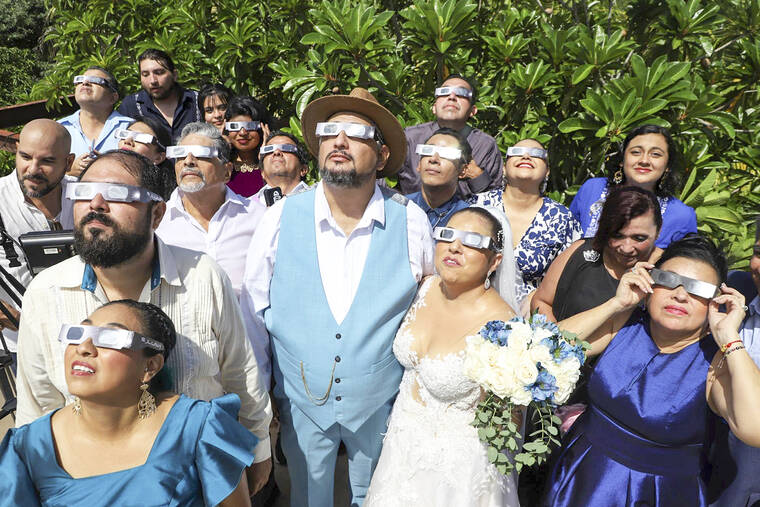Hawaii residents will see a ‘bite taken out of the sun’
Many Hawaii residents are counting down the days to the 2024 solar eclipse on Monday, with some traveling thousands of miles across the ocean to see it in totality.
For those in the Hawaiian isles, only a partial eclipse — and not a total eclipse — will be visible.
ADVERTISING
For the Big Island, the eclipse is expected to begin at about 6:30 a.m. Monday, with nearly 30% eclipsed at 7:12 a.m., according to Roy Gal, associate astronomer at the University of Hawaii Institute for Astronomy.
The percentage eclipsed may vary slightly, from about a quarter to less than a third, depending on location in the isles.
Gal says the partial eclipse should be viewable from anywhere that faces the east.
“If you can see the sunrise from where you are, then you’ll be able to observe the eclipse,” said Gal. “It has to be clear on the horizon.”
Due to Hawaii’s microclimates, he added, one might have to hop in a car if it is cloudy and drive for about 10 minutes to find clearer skies.
When looking at the sun, people should make sure they wear proper solar eclipse glasses with special-purpose solar filters, he said. Sunglasses are not sufficient.
If they are able to view the partial eclipse that morning, he said, it will look “like a bite taken out of the sun.”
The Institute will livestream the partial eclipse from Hawaii starting at 6:30 a.m., followed by observations from the continental U.S. and a Q&A session.
A total solar eclipse occurs when the moon passes between the sun and the Earth, completely blocking the sun’s face.
On Monday, a total solar eclipse is expected to pass over Mexico, the U.S. and Canada, viewable to millions along the “path of totality.” In the U.S., this path crosses 13 states — from Texas to Maine.
The last total solar eclipse viewable from the U.S. occurred in 2017. This year’s will pass over more cities and densely populated areas and last longer, according to NASA.
This phenomenon has captured the imaginations of armchair astronomers and the general public, who describe it a a one-of-a-kind experience, when the daytime sky momentarily turns dark.
But total solar eclipses also provide a valuable opportunity for scientists to gather in-depth observations and data, especially of the sun’s corona, or outer atmosphere.
UH’s award-winning astronomer Shadia Habbal is among a team of researchers sent to strategic locations to gather this valuable insight during this solar eclipse.
They will be stationed at multiple locations, including Texas, Arkansas and Mexico. This year’s event will be Habbal’s 20th total eclipse.
“The corona is always there, but we can’t see it because you have the solar disc that’s so bright,” said Habbal in a news release. “So during a total solar eclipse when the moon blocks the light from the surface of the sun, it dims everything to about the level of nighttime or dusk, so stars, planets, and the corona all appear.”
Mary Beth Laychak of the Canada-France-Hawaii Telescope is planning a trip to visit family in Vermont to view the total solar eclipse — her first.
“A total solar eclipse is one of those times that, even when you understand the science behind it, it feels like magic,” said Laychak, CFHT’s director of communications and community engagement.
From Lake Champlain in Vermont, which is in the path of totality, she expects the moon to completely block the sun for about 3 minutes, 35 seconds, offering a possible glimpse of planets in the daytime that one may not be able to see at night.
“During that time, stars will be visible, the corona will be visible, but also birds will stop chirping,” she said.
Newton Chu of Hilo described his first total solar eclipse in 1991 as an experience he will never forget.
In 1991, Chu experienced the eclipse from the summit of Mauna Kea on Hawaii island, which he described as spectacular. He recalled day turning into total darkness, and then turning into day again within minutes, and witnessing dawn emerge from every direction.
“Once you’ve seen an eclipse, you don’t forget it,” he said. “They’re very special and rare.”
Chu experienced a second total solar eclipse in Sun Valley, Idaho, in 2017 and plans to fly to Indianapolis, Ind., to once again witness the wonder this Monday.
“It’s a long way to go for something, but if you ever have the opportunity to witness a total eclipse it’s really something worth doing,” he said. “It’s a very short event, but because it’s so unusual it’s really worth the journey. I just love being able to witness one of nature’s wonders.”


